
Deposition Date
2011-05-05
Release Date
2012-02-01
Last Version Date
2024-05-15
Entry Detail
PDB ID:
2LCP
Keywords:
Title:
NMR structure of calcium loaded, un-myristoylated human NCS-1
Biological Source:
Source Organism:
Homo sapiens (Taxon ID: 9606)
Host Organism:
Method Details:
Experimental Method:
Conformers Calculated:
100
Conformers Submitted:
20
Selection Criteria:
structures with the lowest energy


